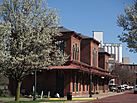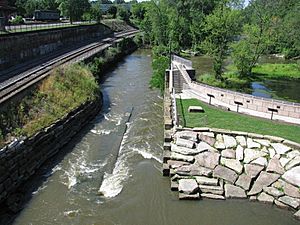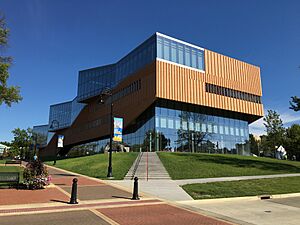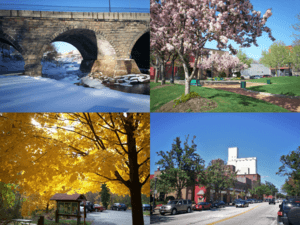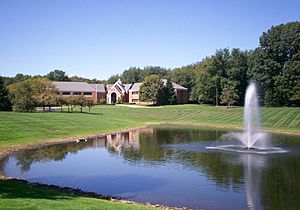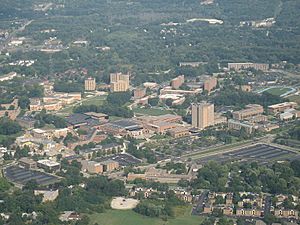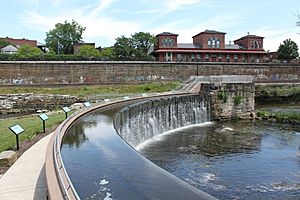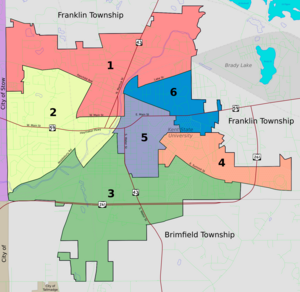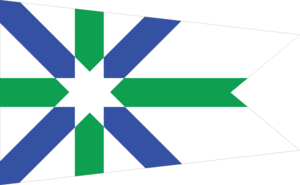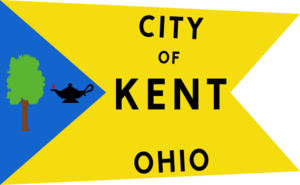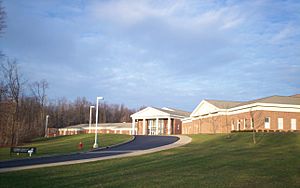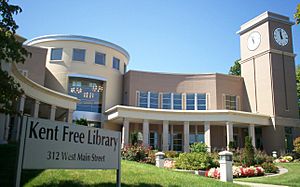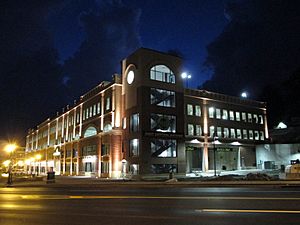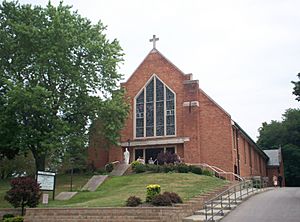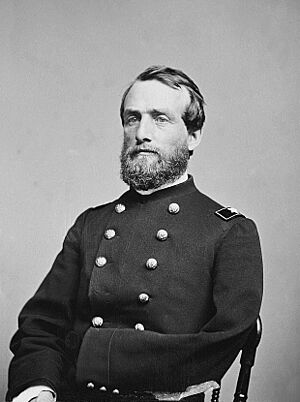Kent, Ohio facts for kids
Quick facts for kids
Kent, Ohio
|
|||
|---|---|---|---|
|
Top from left: old Erie Depot and Star of the West mill, Franklin Hotel, Dix Stadium, Theodore Roosevelt High School, Kent Hall, Main Street Bridge and arch dam, Cuyahoga River
|
|||
|
|||
| Nickname(s):
The Tree City
|
|||
| Country | United States | ||
| State | Ohio | ||
| County | Portage | ||
| Founded | November 1805 | ||
| Incorporated | 1867 | ||
| Founded by | John Haymaker | ||
| Named for | Marvin Kent | ||
| Government | |||
| • Type | Council–Manager | ||
| Area | |||
| • Total | 9.33 sq mi (24.17 km2) | ||
| • Land | 9.22 sq mi (23.89 km2) | ||
| • Water | 0.11 sq mi (0.28 km2) | ||
| Elevation | 1,056 ft (322 m) | ||
| Population
(2020)
|
|||
| • Total | 28,215 | ||
| • Density | 3,059.53/sq mi (1,181.23/km2) | ||
| Demonym(s) | Kentite | ||
| Time zone | UTC−5 (EST) | ||
| • Summer (DST) | UTC−4 (EDT) | ||
| ZIP codes |
44240, 44242, 44243
|
||
| Area codes | 330, 234 | ||
| FIPS code | 39-39872 | ||
| GNIS feature ID | 2395512 | ||
Kent is a city in Ohio, a state in the United States. It is the biggest city in Portage County. Kent is located along the Cuyahoga River in Northeast Ohio. In 2020, about 28,215 people lived there. The city is part of the larger Akron metropolitan area.
Kent was first settled in 1805 and was known as Franklin Mills for many years. Early settlers liked the area because the Cuyahoga River could power mills. Later, the Pennsylvania and Ohio Canal helped the town grow in the 1830s and 1840s. Before the American Civil War, Franklin Mills was a secret stop on the Underground Railroad, helping people escape slavery.
When canals became less important, railroads grew. Marvin Kent helped bring the Atlantic and Great Western Railroad maintenance shops to the town. In 1864, the town was renamed Kent to honor him. It became a village in 1867 and a city after the 1920 Census. Today, Kent is famous for being home to Kent State University, which started in 1910. It is also known as the place of the May 4, 1970 Kent State shootings.
Kent used to be a manufacturing hub, but now education is its biggest industry. Kent State University is one of the largest employers in the area. The Kent City School District and the Kent Free Library also offer many learning chances. The university greatly affects Kent's population, including the average age and income. The city is run by a city manager and a city council. Kent has almost 20 parks and hosts many yearly festivals. These include events for Earth Day, folk music, and Independence Day. Kent is known as "The Tree City" because the Davey Tree Expert Company is based there. People from Kent are called "Kentites".
Contents
- Exploring Kent's Past
- Kent's Location and Landscape
- Who Lives in Kent?
- Kent's Economy and Jobs
- Fun Things to Do in Kent
- Sports and Recreation in Kent
- How Kent is Governed
- Learning in Kent
- Media and News in Kent
- Getting Around Kent
- Faith and Community in Kent
- Famous People from Kent
- Kent's Sister City
- See also
Exploring Kent's Past
Long ago, Native Americans lived in this area, including the ancient Mound Builders. Around 1780, Captain Samuel Brady became famous for his daring jump over the Cuyahoga River to escape capture. This spot, called Brady's Leap, is now a city park. European settlers arrived in the late 1790s. In 1805, John Haymaker and his family moved to the Cuyahoga River banks. They built a gristmill in 1807.
At first, the area grew slowly. Two small villages formed because the river could power mills. The first village was Franklin Mills, or the "Lower Village." Later, Joshua Woodard built more buildings to the north, creating the "Upper Village," briefly known as Carthage.
In the 1820s, the Pennsylvania and Ohio Canal (P & O Canal) was planned to go through Franklin Mills. When the canal was built in the 1830s, many businesses and factories were set up along the river in what is now downtown Kent. A lock and dam were finished in 1836. The canal opened in 1840 but closed by the 1870s.
Before the American Civil War, Franklin Mills had three important stops on the Underground Railroad. These stops offered safe places for people escaping slavery on their way to Canada. One of these stops still stands today. From 1835 to 1839, the famous abolitionist John Brown lived in the village and helped build a tannery.
In 1863, the Atlantic and Great Western Railroad came through Franklin Mills. This happened mostly because of local businessman Marvin Kent. He even got the village chosen for the railroad's maintenance shops in 1864. This made the village an important stop between St. Louis and New York City. The shops opened in 1865 and were vital to Kent's industry until they closed in 1930. To honor Marvin Kent, the village was renamed Kent in 1864. This name change became official when the village was incorporated on May 6, 1867.
John Davey came to Kent in 1881. He was a pioneer in tree surgery. In 1901, he wrote a book called The Tree Doctor. He then started the Davey Tree Expert Company in 1909. Because of John Davey and his company, Kent became known as "The Tree City." This nickname is even on the city's official seal. The company is still based in Kent and is the city's largest private employer.
After a fire destroyed a major factory in 1909, Kent leaders created the Kent Board of Trade in 1910. This group helped Kent be chosen as the site for a new teacher training college. This college became the "Kent State Normal School." William S. Kent, Marvin Kent's son, donated 53 acres of land for the school. By 1929, it was renamed Kent State College, and in 1935, it became Kent State University. The university grew a lot in the 1950s and 1960s, causing Kent's population to double. In 1961, Black squirrels were brought to the campus from Canada. These squirrels have become a symbol for both the university and the city.
In May 1970, protests happened at Kent State University about the Vietnam War. These protests led to the Kent State shootings on May 4, 1970. Four students were killed and nine were hurt by the Ohio Army National Guard. There are now memorials at the site, and events are held every year to remember what happened. In 2010, the site was added to the National Register of Historic Places. It was named a National Historic Landmark in 2016.
In 1995, Kent's water was named "Best Tasting Municipality Water" at a national competition. The city has placed in the top five several times since then. In 2003, the historic 1836 arch dam was changed to meet water quality rules. A small park called Heritage Park was built behind the dam.
From 1881 to 2016, downtown Kent had a flour mill. The mill closed in 2016. In December 2022, part of the old mill complex caught fire, damaging some of the historic buildings.
Downtown Kent's New Look
Starting in 2008, downtown Kent began a big makeover. Many new buildings and projects were started. One of the first was the Phoenix Project, which created a pedestrian alleyway with small shops called Acorn Alley. This opened in 2009. Other new additions included a large parking garage, a hotel, and new office buildings. New offices for Ametek and the Davey Tree Expert Company opened in 2012. The hotel, run by Kent State University, opened in 2013. The new parking garage and bus station, called the Kent Central Gateway, also opened in 2013.
The old Kent hotel, which had been empty since 2000, reopened in 2013 with restaurants, offices, and apartments. A new five-story building called The Landmark was finished in 2014. These projects have made downtown Kent a lively place.
Kent State University also made many improvements on its campus and in the nearby neighborhood. The University Esplanade extension was built to connect the campus with downtown. This path was finished in 2013. A new building for the College of Architecture and Environmental Design opened in 2016. A new facility for the College of Aeronautics and Technology opened in 2015 and was expanded in 2023. A new building for the Ambassador Crawford College of Business and Entrepreneurship is expected to open in 2024.
A new county courthouse opened in 2014. A new city hall is being built and is expected to open in July 2024.
Kent's Location and Landscape
Kent is in the western part of Portage County in Northeast Ohio. It is about 10 miles (16 km) northeast of Akron and 30 miles (48 km) southeast of Cleveland. Kent is surrounded by Franklin Township, Brady Lake, Brimfield Township, and Stow. It is part of the Akron metropolitan area.
Kent has rolling hills and varied land. The Cuyahoga River flows through the city, creating a deep gorge near downtown. The city's elevation is about 1,056 feet (322 m) above sea level. Some parts of Kent State University's campus are even higher, around 1,160 feet (350 m). The city covers about 9.28 square miles (24.0 km2), with most of it being land.
Kent's Weather and Seasons
Kent has a humid continental climate. This means it has warm, humid summers and cold, snowy winters. Spring and autumn are moderate and change a lot. The highest temperature ever recorded was 103 °F (39 °C) in July 1988. The lowest was −22 °F (−30 °C) in January 1982.
In spring and summer, thunderstorms are common. Tornadoes can happen, but the last one in Kent was in 1973. During winter, snow is frequent and can be heavy. Kent is not in the main Lake Erie snowbelt, but it does get some lake-effect snow. Even in winter, temperatures can sometimes rise above 50 °F (10 °C).
Who Lives in Kent?
| Historical population | |||
|---|---|---|---|
| Census | Pop. | %± | |
| 1870 | 2,301 | — | |
| 1880 | 3,309 | 43.8% | |
| 1890 | 3,501 | 5.8% | |
| 1900 | 4,541 | 29.7% | |
| 1910 | 4,488 | −1.2% | |
| 1920 | 7,070 | 57.5% | |
| 1930 | 8,377 | 18.5% | |
| 1940 | 8,581 | 2.4% | |
| 1950 | 12,418 | 44.7% | |
| 1960 | 17,836 | 43.6% | |
| 1970 | 28,183 | 58.0% | |
| 1980 | 26,164 | −7.2% | |
| 1990 | 28,835 | 10.2% | |
| 2000 | 27,906 | −3.2% | |
| 2010 | 28,904 | 3.6% | |
| 2020 | 28,215 | −2.4% | |
Because Kent is a college town, its population is greatly affected by Kent State University. For example, the average age in Kent is much lower than in other parts of Ohio or the U.S. Many residents are between 18 and 24 years old.
Kent's population grew steadily after the railroad arrived in 1863. By the 1930s, Kent became the largest city in Portage County. Between 1950 and 1970, the population nearly doubled, from about 12,000 to over 28,000. Kent remains the county's largest city.
In 2020, there were 28,215 people living in Kent. The city's population is mostly White (81.4%), with African Americans (8.8%) and Asian Americans (3.2%) also living there. About 2.8% of the population is Hispanic or Latino.
There were 10,225 households in 2020. About 20.9% of households had children under 18. The average household size was 2.2 people. The median age in Kent was 23.8 years, which is much younger than the average for Ohio or the United States. This is because of the large number of university students.
The median income for a household in Kent was $37,505 in 2020. This is lower than the state and national averages. About 25.5% of the population lives below the poverty line. However, high poverty rates are common in college towns across the U.S. Many Kent residents have college degrees. In 2020, 44.5% of adults over 25 had a college degree, which is higher than state and national averages.
Kent's Economy and Jobs
Kent's location by the Cuyahoga River and later the canal and railroads made it a good place for mills and factories. In the past, big employers included the railroad shops and manufacturing companies. After a fire in 1909, city leaders worked to bring Kent State University to the city in 1910.
As manufacturing declined, Kent State University grew and became the city's largest employer. The university, city, and private investors have worked together to improve downtown Kent. Kent State also has a research park that helps new high tech companies, especially in the liquid crystal industry.
As of 2020, the biggest job areas in Kent are education, health, and social services. These fields employ 28.4% of Kent's workers. Kent State University and the Kent City School District are the two largest employers. The Davey Tree Expert Company is Kent's largest private employer. It is building a large training and research campus that will be finished in 2025.
Most people in Kent (67.6%) drive alone to work. About 8.2% walk to work, and 1.4% use public transportation. The average commute time is about 21.7 minutes.
Fun Things to Do in Kent
Kent has many cultural events throughout the year, including arts, environmental, and entertainment activities. The Kent State University Museum is also a popular spot.
- The Kent Heritage Festival happens every July in downtown Kent, celebrating Independence Day. It has crafts, entertainment, races, and fireworks.
- In October, Kent State University holds its homecoming festivities, including a parade.
- Downtown Kent also hosts an unofficial Halloween celebration in October, where many people dress in costumes.
- The "Who's Your Mama?" environmental festival takes place around Earth Day each year. It includes concerts, films, and talks about environmental topics.
- Other downtown events include an ice cream social, outdoor concerts, an art and wine festival, a cider festival, and the Festival of Lights Christmas celebration.
- The Wizardly World of Kent is a festival celebrating the Harry Potter books and movies. It happens every July in downtown Kent.
From May to October, the Haymaker Farmers' Market is open every Saturday morning downtown. It is one of the oldest and largest farmers' markets in Northeast Ohio. An indoor Winter Market is held from November through April.
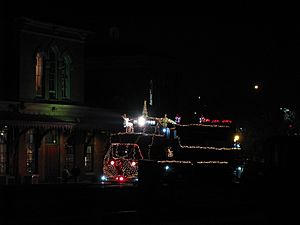
The Kent Stage, located downtown, is a place for music and theater performances. It hosts many concerts and film festivals each year. It is also a venue for the Kent Folk Festival and the Kent Blues Festival.
The Kent State University Museum is on the KSU campus. It shows the history of fashion design and decorative arts. Every May, the university holds an event to remember the Kent State shootings. The May 4 Visitors' Center on campus tells the story of the shootings and their impact.
Kent has several historic sites and districts listed on the National Register of Historic Places.
- The Kent Industrial District shows the city's early industrial history.
- The Ohio State Normal College At Kent district includes the university's first buildings.
- The West Main Street District has historic homes.
- The John Davey House and the Franklin Hotel are also historic landmarks.
Sports and Recreation in Kent
Kent is home to the Golden Flashes, Kent State University's sports teams. They compete in Division I of the National Collegiate Athletic Association (NCAA). The men's basketball team reached the Elite Eight in the 2002 NCAA Tournament. The baseball team played in the 2012 College World Series. The Memorial Athletic and Convocation Center (MAC Center) hosts many sports events, including basketball and wrestling.
Dix Stadium, Kent State's football stadium, also hosts high school football games. The Kent State University Ice Arena is home to local ice hockey teams and ice skating competitions. Kent also hosts the Portage County Open tennis tournament.
Kent has almost 20 parks and preserves. The largest is the 56-acre (23 ha) Fred Fuller Park along the Cuyahoga River. Several parks along the river are near historic sites, like Franklin Mills Riveredge Park and John Brown Tannery Park. Brady's Leap park is where Captain Samuel Brady made his famous jump.
The parks and recreation department offers sports, arts, and education programs. They also host events like Art in the Park and Santa's Arrival. The Kent City School District has an indoor pool at Theodore Roosevelt High School that the public can use.
Segments of the Portage Hike and Bike Trail run through Kent. This trail connects the university campus to downtown. It also links Kent to nearby communities. The Cooperrider-Kent Bog State Nature Preserve in southern Kent is a unique bog with rare trees.
You can also rent canoes, kayaks, and tubes at Tannery Park through Crooked River Adventures. Kent also has a bicycle-sharing system called Flashfleet.
How Kent is Governed
Kent is run by a city manager and a city council with nine members. The city is divided into six areas called wards. Voters choose a mayor, a council member for their ward, and three other council members. The city manager handles the daily operations of city departments. The mayor's role is mostly ceremonial. Jerry Fiala has been mayor since 2010, and Dave Ruller has been city manager since 2005.
Kent has departments for community development, health, law, parks, public safety, and public service. The Public Safety Department includes the police and fire departments. The Kent Police Department also handles 911 calls for Kent and Franklin Township. Kent State University has its own police department for the campus. The fire department has two stations and also serves Franklin Township and Sugar Bush Knolls.
The city gets most of its money from income tax and property tax. In 2014, the city's budget was about $40 million. The largest part of the budget (31%) was spent on public safety.
At the state level, Kent is in the 72nd district for the Ohio House of Representatives and the 27th district for the State Senate. At the national level, Kent is in Ohio's 13th congressional district.
Kent's City Flag
Kent's flag is white with two green stripes and two blue stripes that cross each other, forming an eight-pointed star. The city council adopted it on June 21, 2023. The flag's shape is like the Flag of Ohio.
- The green color stands for agriculture, growth, and hope. The green stripes represent Kent's nickname, "The Tree City."
- The blue color stands for determination and good fortune. The blue stripes represent the Cuyahoga River and the Pennsylvania and Ohio Canal, which were important to Kent's early growth. The crossing blue stripes can also symbolize the railroad.
- The four stripes also represent the four main periods of Kent's history: early times, the canal era, the railroad era, and the modern college town era.
- The eight-pointed star in the middle looks like a quilt star. It symbolizes the North Star and Kent's role in the Underground Railroad. It also stands for the city's history of being welcoming and diverse.
A Kent resident named Zach Garster designed the flag. The city council chose it after getting ideas from many people in the community. The previous flag, adopted in 1975, was yellow with a blue triangle, a lamp of knowledge, and a tree. It was designed by a nine-year-old student.
Learning in Kent
Most children in Kent attend schools in the Kent City School District. This district serves most of Kent and Franklin Township. Kent has four elementary schools for grades K-5, Stanton Middle School for grades 6-8, and Theodore Roosevelt High School for grades 9-12. The district also has a preschool program.
Kent has one private school, St. Patrick School, for students in grades K-8. It is connected to the St. Patrick Catholic parish.
The Kent Free Library is the main public library. It started in 1892. In 1901, Andrew Carnegie donated money to build a permanent library building, which opened in 1903. The library was expanded in 2006 and now has over 166,000 items. It is part of a group of libraries in Portage County.
The main campus of Kent State University is in the southeastern part of the city. The campus covers 866 acres (350 ha). The university also owns more land nearby, including a research park and a golf course. Kent State started in 1910 to train teachers. Today, it is a world leader in developing liquid crystals through its Liquid Crystal Institute. The university's library system has over 2.6 million books. Kent State offers over 300 different study programs. More than 41,000 students attend Kent State across its eight campuses, with over 26,000 at the main campus in Kent.
Media and News in Kent
Kent is part of the Cleveland–Akron television market. This area includes 17 counties in Northeast Ohio. PBS Western Reserve, the Public Broadcasting Service (PBS) station for Akron and Youngstown, has its main studio in Kent. Kent State University also has two student-run television broadcasts.
For radio, Kent is part of the Akron radio market. Two FM radio stations are licensed to Kent:
- WKSU (89.7 FM) is an NPR station owned by Kent State University.
- WNIR (100.1 FM) is a local talk radio station.
Black Squirrel Radio is a student-run internet radio station at Kent State.
The Record-Courier is a daily newspaper that covers Portage County, including Kent. Kent Patch is an online bulletin board for local events. Kent State University also has its own student newspaper, the Kent Stater. The Akron Beacon Journal and The Plain Dealer also cover news in Kent.
Getting Around Kent
State Route 59 is the main east-west highway in Kent. State Route 43 is the main north-south highway. Both are important roads for getting around the city. State Route 261 passes through the southern and eastern parts of Kent.
Public transportation is provided by the Portage Area Regional Transportation Authority (PARTA). PARTA offers bus services within Kent and connects the city to nearby towns like Stow and Ravenna. There are also express routes to Akron and Cleveland. PARTA also runs bus services on the Kent State University campus. The Kent Central Gateway, an intermodal transit facility, opened in 2013 in downtown Kent. It helps connect buses, hike-and-bike trails, and parking.
Kent has three rail lines used by Norfolk Southern and CSX.
Healthcare in Kent
Hospital care in Kent is mainly provided by University Hospitals Portage Medical Center. They operate the UH Kent Health Center, which has an emergency room and urgent care center. The main hospital is in Ravenna. There are also free clinics in Kent.
Faith and Community in Kent
The first organized religious services in Kent were held by a Methodist group in 1815. The oldest church building still used for worship is the Unitarian Universalist Church, built in 1868.
Today, Kent has many different churches, including Roman Catholic, United Methodist Church, African Methodist Episcopal Church, United Church of Christ, Lutheran Church–Missouri Synod, Christian Church (Disciples of Christ), Presbyterian Church, Episcopal Church, and Jehovah's Witnesses. There are also Unitarian Universalist, non-denominational Christian, and Baháʼí Faith groups. While there are no Jewish synagogues in Kent, there is a Hillel International Jewish student center at Kent State University. The Islamic Society of Akron and Kent has a masjid and school nearby.
Famous People from Kent
People from Kent are called "Kentites." John Davey, who started the Davey Tree Expert Company, lived in Kent. His son, Martin L. Davey, later became the Governor of Ohio. Other political figures from Kent include Wisconsin governor Lucius Fairchild and abolitionist John Brown.
Famous athletes from Kent include former National Football League players Mike Adamle, Tom DeLeone, and Stan White. Major League Baseball player and manager Gene Michael also came from Kent.
Three members of the band Devo, which started in Kent in 1973, are from Kent: Gerald Casale, Peter Gregg, and Rod Reisman. Other artists include singer Julianne Baird and voice actor Joshua Seth.
Many famous people lived in Kent while attending Kent State University. These include comedians Drew Carey and Arsenio Hall, actor Michael Keaton, and musicians Joe Walsh and Chrissie Hynde. Athletes who attended Kent State include football players Antonio Gates, James Harrison, Julian Edelman, Joshua Cribbs, and Jack Lambert. Baseball players Thurman Munson, Rich Rollins, and Andy Sonnanstine also went to Kent State. College football coaches Nick Saban and Lou Holtz, and golfer Ben Curtis are also Kent State alumni.
Kent's Sister City
Kent has one sister city, Dudince, in southern Slovakia. This partnership started in 2003 to help people learn about Slovakian culture. The Kent-Dudince Sister City Association organizes cultural exchanges, including Slovakian dance and music.
See also
 In Spanish: Kent (Ohio) para niños
In Spanish: Kent (Ohio) para niños


